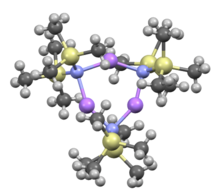Lithium bis(trimethylsilyl)amide
 Monomer (does not exist)
| |
 Cyclic trimer
| |

| |
| Names | |
|---|---|
| Preferred IUPAC name
Lithium 1,1,1-trimethyl-N-(trimethylsilyl)silanaminide | |
| Other names
Lithium hexamethyldisilazide
Hexamethyldisilazane lithium salt | |
| Identifiers | |
3D model (
JSmol ) |
|
| ChemSpider | |
ECHA InfoCard
|
100.021.569 |
PubChem CID
|
|
| UNII | |
CompTox Dashboard (EPA)
|
|
| |
| |
| Properties | |
| LiN(Si(CH3)3)2 | |
| Molar mass | 167.33 g·mol−1 |
| Appearance | White solid |
| Density | 0.86 g/cm3 at 25 °C |
| Melting point | 71 to 72 °C (160 to 162 °F; 344 to 345 K) |
| Boiling point | 80 to 84 °C (176 to 183 °F; 353 to 357 K) (0.001 mm Hg) |
| decomposes | |
| Solubility | Most aprotic solvents |
| Acidity (pKa) | 26 |
| Hazards | |
| Occupational safety and health (OHS/OSH): | |
Main hazards
|
flammable, corrosive |
| Related compounds | |
Related compounds
|
Sodium bis(trimethylsilyl)amide Potassium bis(trimethylsilyl)amide |
Except where otherwise noted, data are given for materials in their standard state (at 25 °C [77 °F], 100 kPa).
| |
Lithium bis(trimethylsilyl)amide is a lithiated
Preparation
LiHMDS is commercially available, but it can also be prepared by the deprotonation of
- HN(Si(CH3)3)2 + C4H9Li → LiN(Si(CH3)3)2 + C4H10
Once formed, the compound can be purified by sublimation or distillation.
Reactions and applications
As a base
LiHMDS is often used in organic chemistry as a strong

where Me = CH3. As such, it finds use in a range of coupling reactions, particularly carbon-carbon bond forming reactions such as the Fráter–Seebach alkylation and mixed Claisen condensations.
An alternative synthesis of tetrasulfur tetranitride entails the use of S(N(Si(CH3)3)2)2 as a precursor with pre-formed S–N bonds. S(N(Si(CH3)3)2)2 is prepared by the reaction of lithium bis(trimethylsilyl)amide and sulfur dichloride (SCl2).
- 2 LiN(Si(CH3)3)2 + SCl2 → S(N(Si(CH3)3)2)2 + 2 LiCl
The S(N(Si(CH3)3)2)2 reacts with the combination of SCl2 and sulfuryl chloride (SO2Cl2) to form S4N4, trimethylsilyl chloride, and sulfur dioxide:[5]
- 2 S(N(Si(CH3)3)2)2 + 2 SCl2 + 2 SO2Cl2 → S4N4 + 8 (CH3)3SiCl + 2 SO2
As a ligand
Li(HMDS) can react with a wide range of metal halides, by a salt metathesis reaction, to give metal bis(trimethylsilyl)amides.
- MXn + n Li(HMDS) → M(HMDS)n + n LiX
where X = Cl, Br, I and sometimes F
Metal bis(trimethylsilyl)amide complexes are lipophilic due to the ligand and hence are soluble in a range of
Niche uses
LiHMDS is volatile and has been discussed for use for atomic layer deposition of lithium compounds.[7]
Structure
Like many

| ||||
TMEDA
|
THF solvated dimer: [(LiHMDS)2(THF)2]
|
 Trimer, solvent free: [(LiHMDS)3] | ||
See also
References
- )
- ^ a b Danheiser, R. L.; Miller, R. F.; Brisbois, R. G. (1990). "Detrifluoroacetylative Diazo Group Transfer: (E)-1-Diazo-4-phenyl-3-buten-2-one". Organic Syntheses. 73: 134; Collected Volumes, vol. 9, p. 197.
- ^ PMID 16836294.
- .
- ISBN 9780471208259.
- ISBN 978-0-470-72184-1.)
{{cite book}}: CS1 maint: multiple names: authors list (link - .
- .
- ^ .
- PMID 27457218.
- ^ Neufeld, R.: DOSY External Calibration Curve Molecular Weight Determination as a Valuable Methodology in Characterizing Reactive Intermediates in Solution. In: eDiss, Georg-August-Universität Göttingen. 2016.
- .
